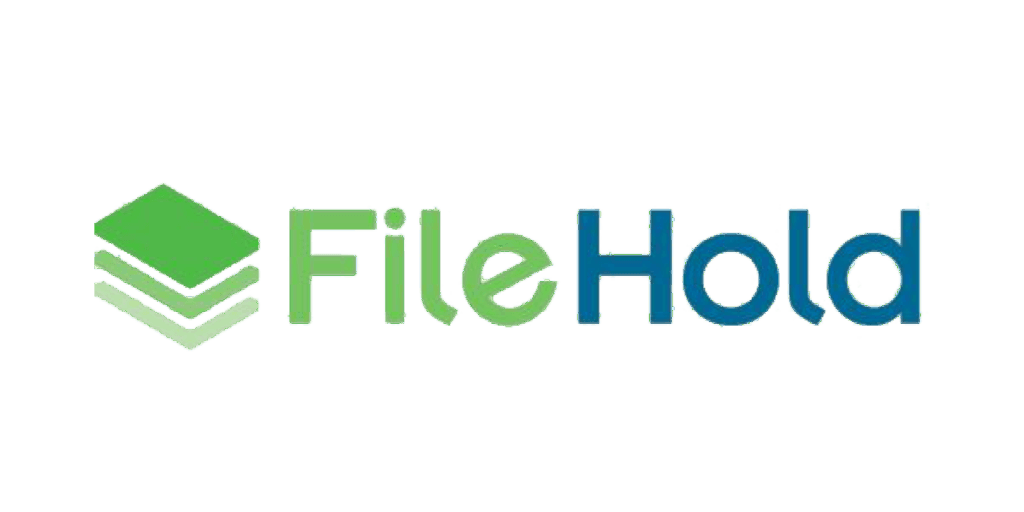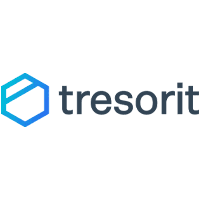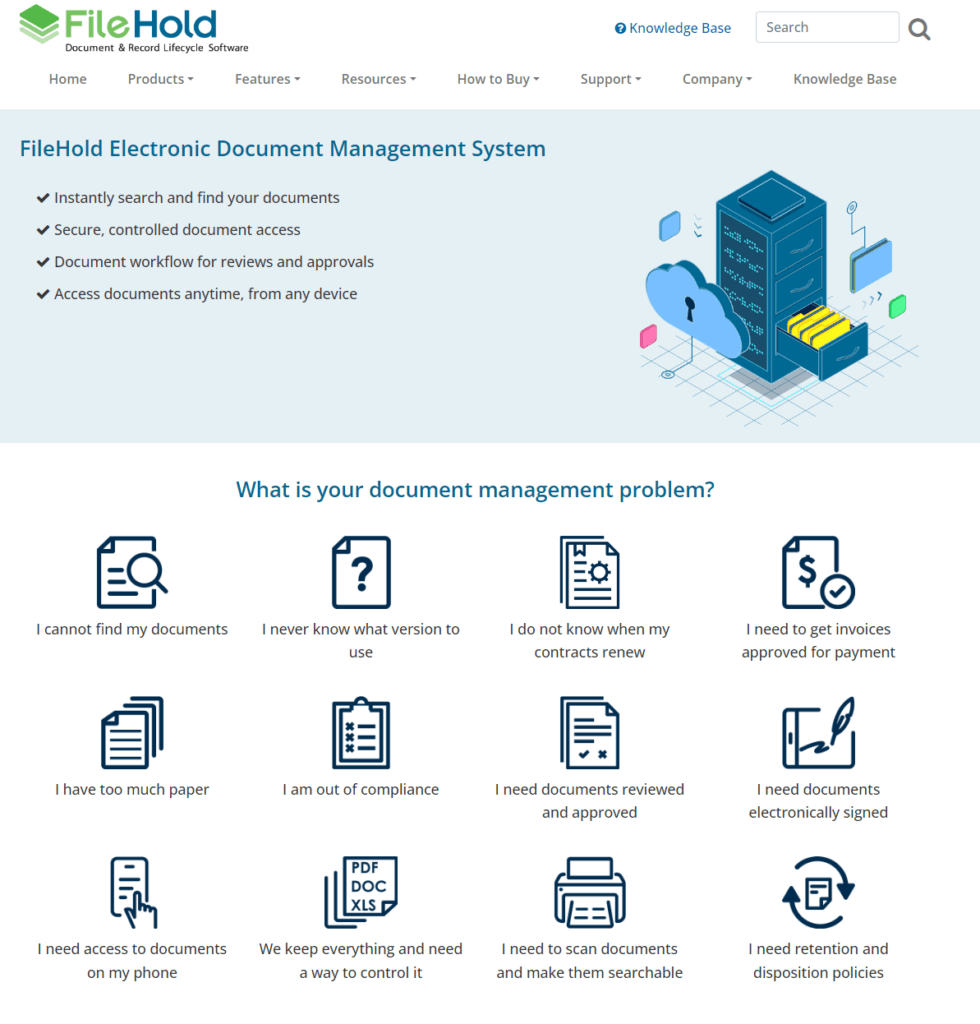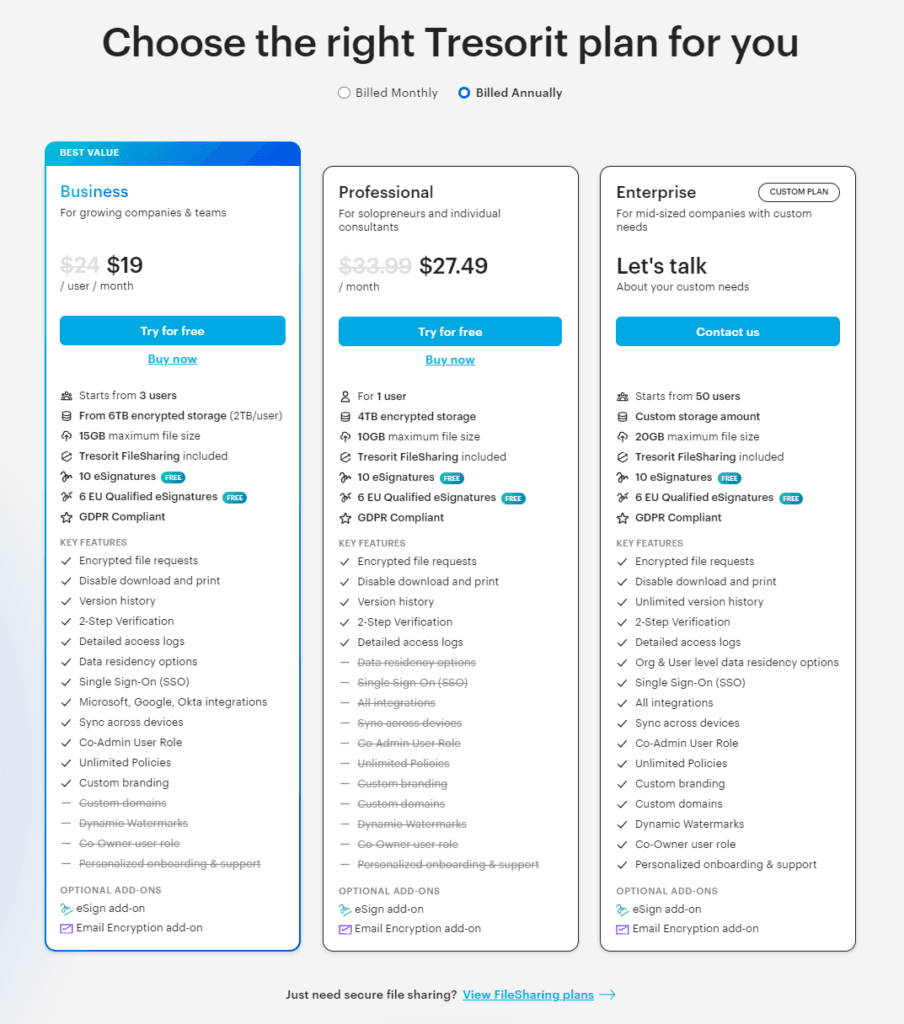In the evolving world of digital documentation, choosing the right tool to manage your files can seem daunting. Today, we’re pitting two popular solutions against each other: FileHold and Tresorit. While both aim to streamline your document management processes, they serve different needs and offer unique features. Let’s dive into the first crucial area of comparison, Security and Compliance to see how FileHold and Tresorit stack up, helping you decide which system might be the best fit for your business’s document management requirements.
FileHold | Tresorit |
|---|---|
| G2 Score – 4.6 out of 5 stars | G2 Score – 4.5 out of 5 stars |
| TrustRadius Score – 7.1/10 | TrustRadius Score – 9.8/10 |
Security and Compliance: A Critical Comparison
In any organization, the security of confidential information is paramount. Both FileHold and Tresorit understand this, but their approaches and capabilities differ significantly, especially given their target markets and core functionalities.
FileHold: Secure Document Management with a Focus on Accessibility
FileHold is designed with enterprise-grade security features that protect documents both at rest and in transit. It utilizes strong encryption protocols such as SSL/TLS for data transmission and AES for data storage. This ensures that documents are safeguarded against unauthorized access, making it suitable for businesses that handle sensitive information but require an on-premise solution.
FileHold excels in regulatory compliance, offering features like audit trails, version control, and permission-based access, which are essential for industries regulated under standards such as HIPAA, GDPR, and Sarbanes-Oxley. The system is particularly adept at helping organizations maintain records in a compliant manner, with tools designed to manage document retention policies effectively.
Tresorit: End-to-End Encryption for Maximum Security
Tresorit takes security to the next level by offering end-to-end encryption—a feature that encrypts data before it leaves your device and keeps it encrypted until the intended recipient accesses it. This means not even Tresorit can access your files, positioning it as one of the most secure cloud storage solutions available, particularly attractive for highly confidential industries.
In addition to robust encryption, Tresorit supports compliance with a broad range of international standards, including GDPR, HIPAA, and others. Its security-first approach ensures that all data handled through its system meets the strictest compliance checks, making it ideal for organizations that operate across borders or in highly regulated sectors.
Integration Capabilities: Connecting Your Business Tools
In today’s interconnected digital landscape, the ability of a document management system (DMS) to integrate seamlessly with existing business tools and software ecosystems is crucial. It directly impacts workflow efficiency and overall productivity. The real test of a DMS is not just in how well it manages documents but also in how effectively it integrates with other applications that your business relies on daily. Let’s compare how FileHold and Tresorit stack up in this vital area.
FileHold: Emphasizing Seamless Integration with Enterprise Systems
FileHold offers excellent integration capabilities with Microsoft Office applications, SharePoint, and various ERP systems. This integration is facilitated through a well-documented API and web services that allow businesses to connect their document management directly with their operational tools. FileHold’s integration with Microsoft Office, for example, enables users to manage documents directly from the familiar Office interface, enhancing user adoption and minimizing disruption.
Beyond basic software integration, FileHold provides powerful tools for automating workflows within the DMS. This includes features for auto-filing documents based on metadata, setting up review and approval processes, and triggering notifications for document-related tasks. These integrations are crucial for businesses looking to streamline document processes and ensure consistent compliance across all operations.
Tresorit: Focused on Secure and Flexible Cloud Integrations
Tresorit’s integration capabilities are designed with the cloud in mind, offering plugins and extensions for Microsoft Office 365 and Outlook, among others. While it might not feature the broad on-premise integration options that FileHold boasts, Tresorit excels in facilitating secure access and sharing capabilities within cloud-based workflows. This includes automated synchronization across devices, which ensures that teams have access to the latest versions of documents no matter where they are.
Tresorit also supports third-party applications like Salesforce and collaboration platforms like Slack, enhancing its utility in environments that rely heavily on cloud services. Tresorit’s API allows for custom integration, enabling businesses to tailor their document management and security needs within their existing cloud ecosystems.
User Experience (UX) and Accessibility: Ensuring User Satisfaction
A DMS’s interface and its ability to provide a seamless user experience are key to its successful deployment and daily use. Let’s compare how FileHold and Tresorit fare in creating a user-friendly environment.
FileHold: Intuitive and Customizable User Interface
FileHold is designed with a focus on user-friendliness. Its interface resembles the familiar structure of traditional file cabinets, making it intuitive for users transitioning from physical to digital document management. The system’s layout is straightforward, with clearly labeled folders and simple navigation paths, which reduces the learning curve and enhances user engagement.
FileHold excels in accessibility by providing a desktop application and a web-based interface that ensure users can access documents from anywhere, whether they are in the office or working remotely. The platform also offers mobile access, although it is more limited compared to its desktop and web counterparts. This broad access helps maintain productivity across various working conditions.
Tresorit: Streamlined and Secure Cloud-Based Access
Tresorit offers a modern, sleek interface that caters to users familiar with cloud-based applications. Its design emphasizes simplicity and security, with drag-and-drop functionality and easy-to-navigate controls. The UI is clean and minimalistic, focusing on essential functionalities that enhance user workflows without clutter.
Being a cloud-native solution, Tresorit provides excellent accessibility, allowing users to access their documents securely from any device, anywhere, without the need for VPNs or other complex configurations. This universal access is a significant advantage for teams that operate remotely or have members frequently traveling.

Related: Check out our free SEO suite

Scalability and System Performance: Preparing for Growth
As businesses expand, their document management needs invariably become more complex and voluminous. A DMS must effectively scale and perform under these evolving conditions to remain a valuable asset.
FileHold: Designed to Scale with Your Enterprise
FileHold is engineered to accommodate growth, from small businesses to large enterprises. The system is built on a scalable architecture that can handle an increasing number of users and a growing volume of documents without a drop in performance. This makes it ideal for organizations that anticipate expansion and require a DMS that can adapt to their evolving needs.
FileHold maintains robust performance regardless of the system load. Its efficient indexing and search functionalities ensure that document retrieval remains fast and reliable, even as the volume of data increases. This performance stability is crucial for maintaining productivity as more users and documents are integrated into the system.
Tresorit: High Performance in a Cloud-Based Setup
Tresorit’s cloud-native framework allows for excellent scalability, particularly suitable for businesses that prefer not to manage physical server infrastructures. The cloud model offers flexibility in storage and user capacity, which can be adjusted according to business needs without significant downtime or investment in additional hardware.
Thanks to its cloud infrastructure, Tresorit delivers high-performance levels consistently. The service ensures that data access and document synchronization are quick and efficient across all devices and users, irrespective of their number or global location. This is particularly advantageous for businesses with remote teams or those in need of accessing large files frequently.
Pricing and Customer Support: Balancing Cost and Quality of Service
Understanding the pricing structure and evaluating the customer support services are essential steps in selecting a DMS that offers not only the right features but also fits within your budget and provides adequate support for your organization’s needs.
FileHold: Transparent Pricing and Dependable Support
FileHold offers a clear and predictable pricing model based on the number of users and the server type (on-premises vs. cloud-based), which allows businesses to scale their costs according to their actual usage and needs. This tiered pricing ensures that companies can start small and expand as they grow, making FileHold a cost-effective option for a wide range of businesses.
FileHold prides itself on providing comprehensive customer support, including detailed documentation, online training modules, and responsive customer service via phone, email, and live chat. Their support team is well-regarded for being knowledgeable and helpful, which is particularly beneficial during the initial setup and ongoing use of the system.
Tresorit: Premium Pricing with Exceptional Support
Tresorit’s pricing is generally higher than FileHold’s, reflecting its advanced security features and cloud-based technology. The company offers several plans tailored to different business sizes and needs, each including full encryption and a suite of collaboration tools. While the cost may be higher, the value is evident in the enhanced security and the ease of use provided by its cloud infrastructure.
Tresorit offers excellent customer support, with a focus on quick and effective resolutions. Support is available through multiple channels, including direct calls and emails with their support team, extensive online resources, and a comprehensive FAQ section. For businesses requiring high security and frequent collaboration, Tresorit’s reliable support ensures minimal downtime and disruption.
Document Collaboration and Sharing: Enhancing Team Productivity
The ability to collaborate on documents efficiently and share them securely are key features that can greatly influence the effectiveness of a document management system (DMS). Let’s delve into how FileHold and Tresorit handle these functionalities.
FileHold:
FileHold offers strong collaboration tools designed to enhance teamwork. Features include version control, which ensures that team members are always working on the latest version of a document. The system also supports check-in/check-out functionalities, preventing conflicts and data loss when multiple users are working on the same document. Additionally, FileHold’s workflow automation tools facilitate document review and approval processes, streamlining how documents are managed and updated.
FileHold allows secure document sharing within the organization. Permissions can be finely tuned, ensuring that only authorized users have access to sensitive information. While its sharing capabilities are robust within the confines of the system, sharing outside the organization or with external stakeholders is more limited compared to cloud-native solutions.
Tresorit:
Tresorit excels in enabling seamless document collaboration, particularly in remote settings. Its cloud-based nature allows team members to access and work on documents from anywhere. Real-time syncing ensures all changes are immediately updated, reducing the risk of version discrepancies. Tresorit also integrates well with common productivity tools like Microsoft Office 365, enhancing its collaboration potential.
One of Tresorit’s standout features is its secure link sharing, which allows users to share documents with anyone, even if they don’t have a Tresorit account. These links can be protected with passwords and expiration dates, and detailed access logs provide visibility into who accessed the document and when. This makes Tresorit highly effective for organizations that frequently need to share documents securely with external parties.
Pricing
FileHold:

Tresorit:

Conclusion
In summary, both FileHold and Tresorit offer robust document management solutions, each excelling in different areas crucial for organizational efficiency and security. The choice between them should be guided by your specific business needs, operational style, and strategic priorities.
FileHold stands out with its strong on-premise solutions, offering extensive customization, solid internal collaboration tools, and a user-friendly interface that integrates seamlessly with Microsoft products. It’s ideal for businesses looking for a reliable, cost-effective DMS with robust security features and a traditional, structured document management approach.
Tresorit excels as a cloud-native platform, providing exceptional security through end-to-end encryption and flexible access across devices. With its advanced sharing capabilities and seamless integration with external platforms, Tresorit is perfect for companies that require high mobility, superior external sharing functionality, and a modern, intuitive user experience.
Read Next:
- GetResponse vs Zoho Campaigns: The Best Email Marketing Tool for 2024
- AWeber vs ActiveCampaign: The Best Email Marketing Tool
- Constant Contact vs Campaigner: Best Email Marketing Tool
- GetResponse vs Omnisend: The Best Email Marketing Tool for 2024
- AWeber vs Benchmark Email: The Best Email Marketing Tool





















